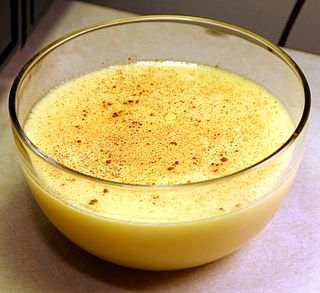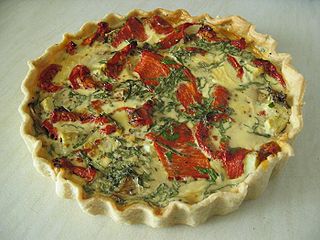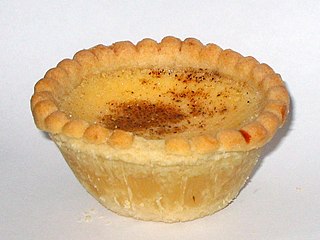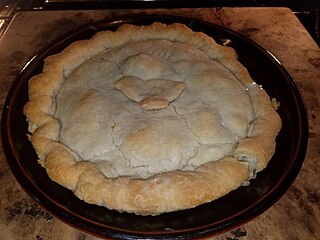
Dessert is a course that concludes a meal. The course consists of sweet foods, such as candy, and possibly a beverage such as dessert wine and liqueur. Some cultures sweeten foods that are more commonly savory to create desserts. In some parts of the world there is no tradition of a dessert course to conclude a meal.

Custard is a variety of culinary preparations based on sweetened milk, cheese, or cream cooked with egg or egg yolk to thicken it, and sometimes also flour, corn starch, or gelatin. Depending on the recipe, custard may vary in consistency from a thin pouring sauce to the thick pastry cream used to fill éclairs. The most common custards are used in custard desserts or dessert sauces and typically include sugar and vanilla; however, savory custards are also found, e.g., in quiche.

Pastry is baked food made with a dough of flour, water, and shortening that may be savoury or sweetened. Sweetened pastries are often described as bakers' confectionery. The word "pastries" suggests many kinds of baked products made from ingredients such as flour, sugar, milk, butter, shortening, baking powder, and eggs. Small tarts and other sweet baked products are called pastries as a synecdoche. Common pastry dishes include pies, tarts, quiches, croissants, and pasties.

A pie is a baked dish which is usually made of a pastry dough casing that contains a filling of various sweet or savoury ingredients. Sweet pies may be filled with fruit, nuts, fruit preserves, brown sugar, sweetened vegetables, or with thicker fillings based on eggs and dairy. Savoury pies may be filled with meat, eggs and cheese or a mixture of meat and vegetables.

Quiche is a French tart consisting of pastry crust filled with savoury custard and pieces of cheese, meat, seafood or vegetables. A well-known variant is quiche Lorraine, which includes lardons or bacon. Quiche may be served hot, warm or cold.

Cheesecake is a dessert made with a soft fresh cheese, eggs, and sugar. It may have a crust or base made from crushed cookies, graham crackers, pastry, or sometimes sponge cake. Cheesecake may be baked or unbaked, and is usually refrigerated.

A tart is a baked dish consisting of a filling over a pastry base with an open top not covered with pastry. The pastry is usually shortcrust pastry; the filling may be sweet or savoury, though modern tarts are usually fruit-based, sometimes with custard. Tartlet refers to a miniature tart; an example would be egg tarts. The categories of "tart", "flan", "quiche", and "pie" overlap, with no sharp distinctions.

A custard pie is any type of uncooked custard mixture added to an uncooked or partially cooked crust and baked together. In North America, custard pie commonly refers to a plain mixture of milk, eggs, sugar, salt, vanilla extract and sometimes nutmeg combined with a pie crust. It is distinctly different from a cream pie, which contains cooked custard poured into a cooled, precooked crust. In the United Kingdom, the comical or political act of pieing is conventionally done with a "custard pie". Some common custard pies include pumpkin pie, lemon and buttermilk chess pie, coconut cream pie, and buko pie. True custard is defined as a liquid thickened with eggs. The often large number of whole eggs in custard pie make it very rich.

A butter tart is a type of small pastry tart highly regarded in Canadian cuisine. The sweet tart consists of a filling of butter, sugar, syrup, and egg, baked in a pastry shell until the filling is semi-solid with a crunchy top. The butter tart should not be confused with butter pie or with bread and butter pudding.

Pastilla is a North African meat or seafood pie made with warqa dough (ورقة), which is similar to filo. It is a speciality of Morocco, Algeria, and Tunisia, where its variation is known as malsouka. It has more recently been spread by emigrants to France, Israel, and North America.

Sweet potato pie is a traditional dessert, originating in the Southern United States among the African American community. It is often served during the American holiday season, especially at Thanksgiving and Christmas in place of pumpkin pie, which is more traditional in other regions of the United States.

Custard tarts or flan pâtissier/parisien are a baked pastry consisting of an outer pastry crust filled with egg custard.

The Southern tomato pie is a tomato dish from the Southern United States. It consists of a pie shell with a filling of tomatoes, covered with a topping of grated cheese mixed with either mayonnaise or a white sauce. It is considered a summer dish, to be made when tomatoes are in season.

Chestnut pie is a pie prepared with chestnuts as a primary ingredient. It is a part of the French cuisine and cuisine of Italy, where it has been documented as dating back to the 15th century. It is also a part of the cuisine of the Southern United States. Shelled whole or chopped chestnuts may be used, which may be boiled or roasted. A chestnut purée may also be used. It may be prepared as a savory or sweet pie.

Moravian chicken pie is a savory meat pie that originated in the colonial town of Salem, North Carolina. It is a traditional double crusted pie made with flaky shortcrust pastry filled with only chunks of poached chicken meat and a thick broth-based sauce. Unlike chicken pot pies, vegetables are never included in the filling. The pie is served in slices with hot chicken gravy on top, and extra gravy on the side. Mashed potatoes are a common accompaniment.

Karantika is an iconic Algerian street food sold throughout Algeria by street vendors. It has similarities to pies, pancakes, and flans and consists of a chickpea batter topped with beaten egg and baked, and is served with harissa and cumin either hot on bread as a sandwich, or sliced into squares.
















